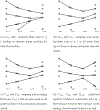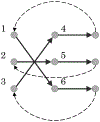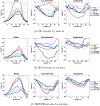Flow network tracking for spatiotemporal and periodic point matching: Applied to cardiac motion analysis
- PMID: 31055125
- PMCID: PMC6939679
- DOI: 10.1016/j.media.2019.04.007
Flow network tracking for spatiotemporal and periodic point matching: Applied to cardiac motion analysis
Abstract
The accurate quantification of left ventricular (LV) deformation/strain shows significant promise for quantitatively assessing cardiac function for use in diagnosis and therapy planning. However, accurate estimation of the displacement of myocardial tissue and hence LV strain has been challenging due to a variety of issues, including those related to deriving tracking tokens from images and following tissue locations over the entire cardiac cycle. In this work, we propose a point matching scheme where correspondences are modeled as flow through a graphical network. Myocardial surface points are set up as nodes in the network and edges define neighborhood relationships temporally. The novelty lies in the constraints that are imposed on the matching scheme, which render the correspondences one-to-one through the entire cardiac cycle, and not just two consecutive frames. The constraints also encourage motion to be cyclic, which an important characteristic of LV motion. We validate our method by applying it to the estimation of quantitative LV displacement and strain estimation using 8 synthetic and 8 open-chested canine 4D echocardiographic image sequences, the latter with sonomicrometric crystals implanted on the LV wall. We were able to achieve excellent tracking accuracy on the synthetic dataset and observed a good correlation with crystal-based strains on the in-vivo data.
Keywords: Echocardiography; Flow network; Motion; Neural networks.
Copyright © 2019 Elsevier B.V. All rights reserved.
Figures





























References
-
- Alessandrini M, De Craene M, Bernard O, Giffard-Roisin S, Allain P, Waechter-Stehle I, Weese J, Saloux E, Delingette H, Sermesant M, et al., 2015. A pipeline for the generation of realistic 3d synthetic echocardiographic sequences: methodology and open-access database. IEEE transactions on medical imaging 34, 1436–1451. - PubMed
-
- ApS, M., 2014. The MOSEK optimization toolbox for MATLAB manual. Version 7.0. http://docs.mosek.com/7.0/toolbox/index.html.
-
- Belongie S, Malik J, Puzicha J, 2000. Shape context: A new descriptor for shape matching and object recognition, in: NIPS, p. 3.
-
- Berclaz J, Fleuret F, Turetken E, Fua P, 2011. Multiple object tracking using k-shortest paths optimization. IEEE transactions on pattern analysis and machine intelligence 33, 1806–1819. - PubMed
Publication types
MeSH terms
Grants and funding
LinkOut - more resources
Full Text Sources

